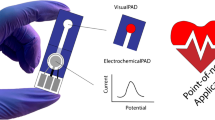Abstract
The catalyzed reporter deposition (CARD) method of signal amplification, also called “tyramide signal amplification”, has been used in immunoassays not only to increase sensitivity but also to reduce assay time. The current approach to tyramide amplification in immunoassays involves slow incubation with agitation. In this paper we describe new filtration-based tyramide amplification and substrate visualization techniques. Compared with the standard method, this new approach greatly enhances spot intensities in membrane immunoassay and reduces biotinylated tyramide (B-T) and substrate consumption approximately fiftyfold, without loss of specificity. An improved test device and a cost-effective method for preparation of membranes for Super-CARD amplification have also been developed. The techniques have been used for rapid detection of aflatoxin B1 (AFB1) in a variety of foodstuffs with a detection limit of 12.5 μg kg−1. The assay procedure involves sequential addition of standards or sample, AFB1–horseradish peroxidase (HRP) conjugate, B-T, avidin–HRP, and substrate solution over anti-AFB1 antibody-spotted zones of the membrane surface. The method saves time, improves reproducibility, eliminates many washing steps and avoids manipulation of the membranes between the different steps, while maintaining the sensitivity of the standard method. Average recoveries from different non-infected food samples spiked with AFB1 at concentrations from 25 to 100 mg kg−1 were between 95 and 105%. AFB1 results obtained on different days for Aspergillus parasiticus infection of corn and groundnut samples correlated well with estimates obtained by HPLC.

The principle of filtration-based tyramide filtration technique





Similar content being viewed by others
References
Bates DL (1987) Trends Biotechnol 5:204–212
Bobrow MN, Harris TD, Shaughnessy KJ, Litt GJ (1989) J Immunol Methods 125:279–285
Bobrow MN, Shaughnessy KJ, Litt GJ (1991) J Immunol Methods 137:103–112
Köhler A, Lauritzen B, van Noorden CJF (2000) J Histochem Cytochem 48:933–941
Mayer G, Bendayan M (1997) J Histochem Cytochem 45:1449–1454
Bhattacharya R, Bhattacharya D, Dhar TK (1999) J Immunol Methods 227:31–39
Pal A, Dhar TK (2004) Anal Chem 76:98–104
Pal A, Acharya D, Saha D, Dhar TK (2004) Anal Chem 76:4237–4240
Xu Y, Bao G (2003) Anal Chem 75:5345–5351
Morais S, Maquieira A, Puchades R (1999) Anal Chem 71:1905–1909
Clark CR, Kresl JJ, Hines KK, Anderson BE (1995) Anal Biochem 228:232–237
Bhattacharya D, Bhattacharya R, Dhar TK (1999) J Immunol Methods 230:71–86
Saha D, Acharya D, Dhar TK (2006) Anal Bioanal Chem 385:847–854
Acknowledgements
This work was supported in part by a grant from the Department of Biotechnology, Delhi. We thank the Council of Scientific and Industrial Research, Delhi for a Research Fellowship to D.S and D.A.
Author information
Authors and Affiliations
Corresponding author
Rights and permissions
About this article
Cite this article
Saha, D., Acharya, D., Roy, D. et al. Filtration-based tyramide amplification technique—a new simple approach for rapid detection of aflatoxin B1 . Anal Bioanal Chem 387, 1121–1130 (2007). https://doi.org/10.1007/s00216-006-0943-y
Received:
Revised:
Accepted:
Published:
Issue Date:
DOI: https://doi.org/10.1007/s00216-006-0943-y



